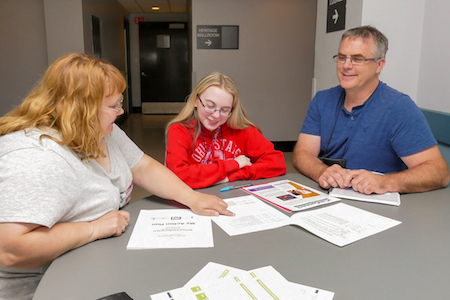Recommendation 6: Educate Families
Educate and inform families about the transition process, adult laws and services, and the rights of children regarding transition services and long-term supports.

Why This Is Important
To make informed choices for their children’s life after graduation, families need accurate information on a wide range of topics including how adult service systems function and how to ask for what their children need.
They also need information about their children’s rights, including:
- The Individuals with Disabilities Education Act regulations concerning transition to postsecondary outcomes
- The Americans with Disabilities Act and how it impacts services for people with disabilities
- The Workforce Investment Opportunity Act and how it impacts employment supports and opportunities for students
- Employment First policies
- The Center for Medicaid and Medicare Final Settings Rule
Perhaps most importantly, families must have high expectations for their children and know that positive employment and community-living outcomes are possible (Advisory Committee on Increasing Competitive Integrated Employment for Individuals with Disabilities, 2016). Two significant predictors of competitive integrated employment for a young adult with a severe disability are: 1) family expectations that their child will work and 2) having responsibilities at home (Carter, Austin, & Trainor, 2012).
Interviews with families conducted in the course of developing these recommendations identified a number of training and information needs. National Family Association for Deaf-Blind representatives reported that families need help understanding how to determine which Medicaid waivers apply to their children and how to access them. They also highlighted the importance of empowering and supporting families to navigate vocational rehabilitation (VR) services. For example, what to do when VR says your child is not employable, but you, as a parent, know differently.
Several families reported that having support from a knowledgeable person to help them navigate adult systems and the use of a person-centered planning process, enabled them to identify what they really wanted for their child and gave them permission to dream for a life that was a good fit rather than picking from a menu of available options that might or might not be appropriate. Sometimes what a family wants for their child doesn’t currently exist, but with persistent requests and advocacy, systems can be influenced and changed. When families know what they want for their children, what their rights are, and how to ask for what they need, they are better equipped to get it.
Importance of parent involvement:
What State Deaf-Blind Projects Can Do
1. Learn about services for families in your state.
- Contact your state’s Parent Center to find out what it offers families regarding transition, WIOA, customized employment, and navigating adult service systems.
- Identify other efforts to educate families about adult services. Do individual schools have transition forums for families? Is there a family strand at your state transition or Council for Exceptional Children conference?
- Determine what your state’s protection and advocacy organization can do when a young adult is not getting what he or she needs for employment preparation and access.
- Identify sources of long-term funding for services.
2. Ensure that families and students have accurate and timely information about adult services.
Families need to know about available services, eligibility requirements, timelines for getting their child determined as eligible for a service, and timelines for applying for a service (these are sometimes different than eligibility timelines). There are waiting lists for long-term supports in many states and parents should get their children on those lists as early as possible.
Resources:
- Helen Keller National Center Regional Representatives
- READY Tool: Readiness Evaluation of Transition to Adulthood for Deaf-Blind Youth
- Adult Agencies (Fact Sheet)
- Adult Services Funding (Fact Sheet)
3. Ensure families have information about their choices regarding guardianship and alternatives to guardianship.
Resources:
- Guardianship and Alternatives for Decision-Making Support
- Alternatives to Guardianship
- National Guardianship Association
4. Ensure families have accurate information about the impact of income on their child’s eligibility for Medicaid and understand the difference between income and resources.
Because Medicaid funds long-term supports, families are justifiably cautious about doing anything that may jeopardize their child’s eligibility. Unfortunately, a great deal of misinformation is circulated. To maintain Medicaid eligibility, individuals must meet medical eligibility qualifications, resource limits, and keep their wages below state earnings thresholds. Eligibility requirements and resource limits are stipulated by specific waivers. For information about waiver programs in your state, see the State Waivers List.
5. Support parent organizations that are lobbying for better services.
- Ask your state’s developmental disabilities council if they have a leadership program for parents and individuals with developmental disabilities such as Partners in Policymaking.
- Connect families to training on on how to effectively serve on decision-making groups, such as Serving on Groups that Make Decisions: A Guide for Families.
6. Connect families.
Connect families who are working on the same outcomes for their children so they can share ideas, successful strategies, and challenges. You may also want to consider linking families who are just beginning the transition process or having difficulties with families that have successfully designed and created unique adult lives for their children.
7. Join “Supporting Families of Individuals with Intellectual and Developmental Disabilities,” a national community of practice.
The goal of this community of practice (CoP) is to build capacity across and within states to create policies, practices, and systems to better assist and support families that include a member with intellectual and developmental disabilities. Visit the website to learn more and determine if there is a CoP already established in your state.
Promising Examples
FEAT (Family Employment Awareness Training)
FEAT is a two-part training curriculum for families developed at the University of Kansas (Gross et al., 2015). It focuses on building family expectations of employment for their young adult children and making connections to local resources. Success stories and creative strategies are shared to show that community employment is possible for everyone. Families and youth learn about models of employment including customized, supported, and self-employed, as well as strategies such as resource ownership and job carving. Participants learn to distinguish quality services from those that are substandard. Youth are pulled out during parts of the training to talk about their perspectives, strengths, and interests.
The program includes extensive information about resources, both disability specific and universal. Because participants attend training in their own regions, the resources discussed are locally available. Representatives from community organizations attend to develop connections with students and their families.
At the end of the training, families identify five "next steps" for their child’s transition planning and five resources they can bring to their IEP teams. Technical assistance is available to groups or individuals after the initial two-day training. There is also a train-the-trainer model which state deaf-blind projects could consider using to increase capacity in their states.
The Beach Center at the University of Kansas has more information about the FEAT program, including how to offer it in your state.
